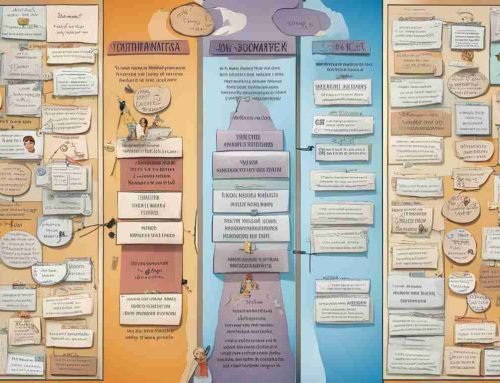Intrinsic motivation is crucial in driving individuals to achieve their goals and excel in various aspects of life. It refers to the internal factors that stimulate and inspire individuals to engage in activities for their inherent satisfaction rather than for external rewards or incentives. Understanding the different types of intrinsic motivation components can provide valuable insights into how individuals can be motivated from within.
1. Curiosity and Interest
Curiosity and interest are powerful intrinsic motivators that drive individuals to explore, learn, and understand new concepts and experiences. When genuinely curious about a subject or activity, individuals are more likely to engage actively, seek out information, and persist in their efforts. Curiosity sparks a sense of wonder and excitement, promoting deeper engagement and intrinsic motivation.
- Curiosity helps individuals expand their knowledge and understanding by encouraging them to ask questions and seek out answers.
- It drives individuals to explore new possibilities, developing innovative thinking and problem-solving skills.
- When individuals are genuinely interested in a topic, they are more likely to put in the necessary effort to master it, resulting in a deeper level of expertise.
Examples of Curiosity and Interest
1. Reading about a new scientific discovery out of curiosity
Curiosity can motivate reading about new scientific discoveries to enjoy learning new information. Being intrinsically interested in science leads to exploring more about new innovations and knowledge advancements in the field.
2. Asking questions to learn more about a hobby of interest
When intrinsically curious about a new hobby, people are driven to ask questions to satisfy their interest in learning more. Their curiosity motivates them to gain deeper knowledge about inherently fascinating activities.
3. Seeking out courses to expand knowledge in an area of interest
Individuals motivated by curiosity actively seek out courses and classes to keep growing their knowledge in topics of personal interest. The desire to learn intrinsically drives them to study subjects they find engaging formally.
2. Mastery and Competence
The desire for mastery and competence is a key intrinsic motivation component. When individuals feel a sense of progression, growth, and improvement in their skills or knowledge, they become more motivated to continue their endeavors. Developing a sense of mastery and competence fosters a sense of accomplishment and satisfaction, driving individuals to exceed their own expectations.
- Mastery provides individuals with a sense of confidence and self-efficacy, which boosts their motivation to tackle more challenging tasks.
- It allows individuals to set higher goals and strive for continuous improvement, leading to personal and professional growth.
- Mastering a particular area often leads to a sense of fulfillment and pride, reinforcing intrinsic motivation.
Examples of Mastery and Competence
1. Perfecting a tennis serve through extensive practice
The motivation to master a skill leads people to put in extensive practice time perfecting abilities like a tennis serve. Their internal drive for competence fuels persistence until techniques are expertly executed.
2. Learning new pieces to improve piano skills
The intrinsically motivated piano student driven by mastery constantly learns new pieces to hone their technical skills. Each new piece presents opportunities for personal growth and competency development.
3. Advancing to higher levels in a video game through practice
Video game players seeking mastery play repeatedly to advance to higher difficulty levels and acquire new abilities. The satisfaction of progression and improvement motivates this continual effort and practice.
3. Autonomy and Control
Having a sense of autonomy and control over one’s actions and decisions is essential for intrinsic motivation. When individuals feel empowered to make choices and have a sense of ownership in their pursuits, they are more likely to be intrinsically motivated. Autonomy allows individuals to align their goals and actions with their values and interests, leading to greater fulfillment and motivation.
- Autonomy fosters a sense of responsibility and accountability, as individuals can make decisions and take ownership of their actions.
- It promotes creativity and innovation, as individuals can explore different approaches and solutions without external constraints.
- Individuals who control their work environment and processes are more likely to feel motivated and engaged.
Examples of Autonomy and Control
1. Choosing what projects to work on at your job
Having autonomy in the workplace provides the freedom to choose what projects to undertake based on personal interests and strengths. This ability to self-direct enhances internal motivation.
2. Selecting the topic for a research paper based on your interests
Students intrinsically motivated by autonomy get to select their research paper topic based on individual interests rather than being assigned a subject. This fosters engagement.
3. Deciding what activities to schedule for the day
Control over one’s schedule allows intrinsically motivated individuals to structure their day as they wish and pursue activities aligned with internal goals.
4. Challenge and Achievement
The desire for challenge and achievement is a strong intrinsic motivator that pushes individuals to set ambitious goals and strive for success. When individuals are provided with challenging tasks or objectives within their capabilities, they are more likely to experience satisfaction and fulfillment upon achieving them. The process of overcoming obstacles and reaching milestones contributes to intrinsic motivation.
- Challenges allow individuals to test their skills and capabilities, leading to personal growth and development.
- Overcoming challenges instills a sense of resilience and perseverance, which enhances intrinsic motivation for future endeavors.
- Achieving goals and experiencing a sense of accomplishment boosts individuals’ self-esteem and confidence, reinforcing their intrinsic motivation.
Examples of Challenge and Achievement
1. Solving a Rubik’s cube through persistence and problem-solving
The motivation for challenge and personal achievement drives people to persist at solving tricky puzzles like the Rubik’s cube. Their inner drive pushes them to keep developing solutions.
2. Finishing a challenging hike that tested your physical limits
Driven individuals pursuing challenges complete strenuous hikes that test their endurance and stamina. The sense of accomplishment upon finishing such a hike reinforces intrinsic motivation.
3. Mastering a complex piece on the piano after much practice
Intense practice motivated by the internal drive for success allows piano students to master even the most challenging musical pieces eventually. This fuels their intrinsic motivation.
5. Enjoyment and Fun
Intrinsic motivation is often linked to the enjoyment and fun individuals derive from an activity. When individuals find an activity enjoyable and pleasurable, they are motivated to continue engaging. The positive emotions associated with enjoyment and fun enhance intrinsic motivation, making individuals more likely to invest their time and effort willingly.
- Engaging in enjoyable activities reduces stress and promotes overall well-being, leading to a positive mindset and increased motivation.
- Fun activities create a sense of anticipation and excitement, making individuals more eager to participate and excel.
- The positive emotions experienced during enjoyable activities enhance individuals’ intrinsic motivation, making them more likely to pursue similar activities in the future.
Examples of Enjoyment and Fun
1. Playing a sport you find thrilling and enjoyable
Individuals driven by intrinsic enjoyment and fun gravitate towards sports they find pleasurable to play to have a good time participating.
2. Exploring a new city on vacation just for the fun of it
Vacationers are often intrinsically motivated to explore and see the sights of a new city simply for the fun, excitement, and enjoyment of discovering someplace new.
3. Completing an entertaining crossword puzzle during leisure time
Crossword puzzles provide a fun, relaxing, and engaging experience for those driven by inherent enjoyment in the activity itself rather than any external reward.
6. Personal Meaning and Purpose
Finding personal meaning and purpose in an activity is a significant intrinsic motivation component. When individuals identify a greater purpose or significance in their actions, they are more likely to be intrinsically motivated. Understanding how an activity aligns with their values, beliefs, and long-term goals fosters a sense of purpose and intrinsic motivation.
- Connecting activities to personal values and beliefs gives individuals a sense of fulfillment and a reason to invest time and effort.
- A clear understanding of how an activity contributes to long-term goals gives individuals a sense of direction and motivation.
- When individuals find personal meaning and purpose in their pursuits, they are more likely to derive intrinsic satisfaction and fulfillment from their efforts.
Examples of Personal Meaning and Purpose
1. Volunteering to support a cause you care deeply about
Finding a charitable purpose often motivates people to volunteer for causes aligned with their values. The sense of meaning promotes intrinsic motivation.
2. Learning new skills to start your dream career
Some are driven by the deeper purpose of preparing for a meaningful career through acquiring knowledge and skills related to their dream job.
3. Making art that expresses your inner vision and creativity
Creating art allows intrinsically motivated individuals to tap into their creativity and express a personal vision. This sense of meaning enhances engagement in the artistic process.
7. Flow State
Flow state refers to optimal engagement and complete immersion in an activity. When individuals experience a flow state, they are fully absorbed in the task at hand, losing track of time and external distractions. Achieving a flow state often leads to enhanced intrinsic motivation, as individuals feel a sense of effortless focus and enjoyment.
- Flow state is characterized by a deep sense of concentration and high productivity levels, leading to accomplishment and satisfaction.
- It promotes a sense of timelessness, as individuals are fully engrossed in the present moment, enhancing intrinsic motivation.
- Flow state is often associated with energized focus and enjoyment, making individuals more likely to be intrinsically motivated to engage in similar activities.
Examples of Flow State
1. Producing music in a state of energized focus and concentration
Musicians may experience flow states of heightened stress and immersion while producing music, driven by the intrinsically rewarding nature of the creative process.
2. Thoroughly absorbed in coding a complex program you’re building
Programmers are sometimes intrinsically motivated by the flow experience while coding, becoming thoroughly absorbed in architecting complex software systems.
3. Being fully engaged in a conversation with a close friend
Meaningful conversations can prompt flow states, where individuals are completely engaged with a close friend’s ideas and lose track of surrounding distractions.
Conclusion
Understanding the different types of intrinsic motivation components can help individuals harness their internal drive and reach their fullest potential. Individuals can enhance their satisfaction, productivity, and overall well-being by recognizing and nurturing these components. Curiosity, mastery, autonomy, challenge, enjoyment, personal meaning, and flow state all drive intrinsic motivation. By embracing these components, individuals can unlock their innate motivation and achieve remarkable success in various aspects of life.
FAQ
1. What are the types of intrinsic motivation components discussed in the article?
The types of intrinsic motivation components discussed in the article are curiosity and interest, mastery and competence, autonomy and control, challenge and achievement, enjoyment and fun, personal meaning and purpose, and flow state.
2. How do curiosity and interest contribute to intrinsic motivation?
Curiosity and interest contribute to intrinsic motivation by expanding knowledge, promoting innovative thinking and problem-solving skills development, and encouraging individuals to try to master a topic.
3. Why are autonomy and control essential for intrinsic motivation?
Autonomy and control are essential for intrinsic motivation because they foster responsibility, creativity, and innovation. They also allow individuals to align their goals and actions with their values and interests, leading to greater fulfillment and motivation.
4. How does the desire for challenge and achievement enhance intrinsic motivation?
The desire for challenge and achievement enhances intrinsic motivation by providing opportunities for personal growth and development, instilling resilience and perseverance, and boosting self-esteem and confidence upon achieving goals.





